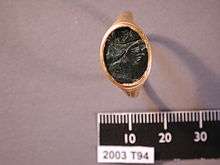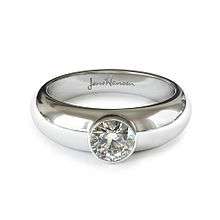Bezel (jewellery)



The bezel of a ring is a wider and usually thicker section of the hoop, which may contain a flat surface, usually with an engraved design, as in a signet ring, or a gem.[1] The ring is normally worn to display the bezel on the upper or outer side of the finger. The word may also refer to a bezel setting for a stone, which is a general term for a setting holding the stone in place using a raised surrounding for the stone with a lip encircling and overlapping the edges of the stone, thus holding it in place.[2] Modern bezel settings typically use a band of metal containing a groove and a flange (i.e. projecting lip) to hold a watch crystal or gemstone in its setting. This was the earliest method of setting gemstones into jewelry, in historic examples often made by leaving a hole or slot in the ring with a thin lip which was bent over once the stone was inserted, holding it in place. An extension of the word used in this sense can refer to a rotatable rim on a clock or watch used to indicate certain data such as elapsed time.[3][4]
Other types of bezels, less used in modern jewelry, are "swivel bezels" where the bezel, perhaps just formed of a stone with a metal rod through it, can rotate, and "box bezels", where a "box" or cage forms the bezel, often sitting on the main ring hoop, and perhaps open at the top where there is a stone.[5]
In gem-cutting bezel may also refer to the sloping faces of a cut stone round the flat "table" face (another meaning of the word is the sloping face of a chisel)[6]
More broadly, bezels are found on tools and appliances. It is the diagonal face at the end of the blade of a chisel, or similar implement, leading to the edge. In vehicles, it is the part of the vehicle's bodywork that surrounds a headlight or turn signal.[7] On a cell phone, it is the back surface that frames the LCD screen.[8]
Bezel settings

In making a typical modern bezel setting the bezel is shaped into the size and shape of the gem and then soldered into place on the metal of the jewelry. The prepared stone is then placed into the bezel and the metal is pressed down over the edges of stone, locking it into place.
A cabochon stone, a gemstone that is not faceted, usually relies on the shallow angle cut into the side of the stone which helps the metal to stay in place. With a clear faceted stone, such as a diamond, a shallow groove is cut into the bezel itself. The girdle or widest part of the gem stone is placed in the bezel, which is then pushed down over the girdle. The pressure of the bezel over the edge of the diamond keeps it in place.
Bezel settings for diamond rings are also called rub-over settings; they have a diamond completely surrounded by a precious metal band which fastens the diamond securely into place. Bezel settings use a type of elevated collar which wraps the rim of the diamond in a complete metal edging. This type of diamond rings setting is the most secure fastener for the stones. The bezel setting also protects the diamond better than other types of settings, such as the prong setting. A flush setting for diamond rings is a variation on the rub-over or bezel setting. In the flush setting, the stone is placed into an opening and affixed at the bottom of the stone. The top of the diamond is extended above the base.
Advantages
One advantage of the bezel setting as compared to the prong setting is that the diamond is better protected from accidental rubbing or blows, and is less likely to allow the diamond to scratch or mar something it comes in contact with. The bezel setting is also more secure, so the diamond is less likely to be dislodged by the wearer's activity.
Notes
- ↑ McConnell, 104
- ↑ "A bezel setting is a metal rim that holds the gem in a finger ring. The term is used in a transferred sense by horologists to denote the ring that secures the glass in a watch or clock, and by metal specialists to describe the ring inside the lid of silver and pewter objects", Campbell.
- ↑ Oxford English Dictionary (all editions to 2013), "Bezel", n. 3. However the OED definition misses the primary sense given in its own citations, such as: "1616 J. Bullokar Eng. Expositor, Bezill, the broad part of a ring, in which the stone or signet is set.", only defining it as "The groove and projecting flange or lip by which the crystal of a watch or the stone of a jewel is retained in its setting." For examples of "bezel" referring to flat, thick parts of rings with no gems, flanges or lips see the over 2,000 uses of the word (in records with images) in the British Museum collection database.
- ↑ Webster's New World College Dictionary (2005)
- ↑ Examples in the British Museum, with descriptions: Gold ring with movable circular box-bezel decorated with a griffin (also swivels); box bezel, no stone; The "Ashburnham Ring", with swivel bezel.
- ↑ OED, "Bezel" noun, 1 and 2; "In lapidary usage, the oblique sides or faces of a cut gem", Campbell.
- ↑ "bezel". Dictionary.com. Based on the Random House Dictionary. Retrieved July 11, 2013.
- ↑ Strange, Adario (July 11, 2013). "LG intros world's thinnest smartphone screen". DVICE.
References
- Campbell, Gordon, "Bezel", Grove Art Online, Oxford Art Online, Oxford University Press, Accessed 4 July 2013, Subscription required